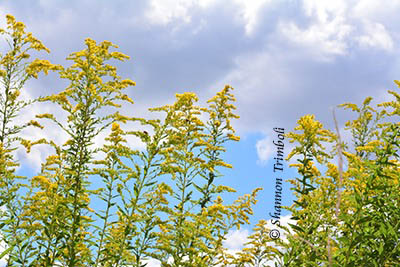
Goldenrods (Solidago spp.) are in the aster family – the same family as daisies, sunflowers, and asters. The USDA Plants Database lists 33 species of goldenrods that are native to Kentucky. Two of those species, the white-haired goldenrod (Solidago albopilosa) and Short’s goldenrod (Solidago shortii) are federally endangered. The giant goldenrod (Solidago gigantea) is Kentucky’s state flower, although everyone shortens it to just goldenrod.
One reason that everyone refers to goldenrods as a group is because they are notoriously hard to identify to species. I took several botany courses while in college. Most of those classes were the type where you spent most of the time in the field learning to identify the plants you found. My professors’ advice when it came to goldenrods was to stop there unless you were a goldenrod expert or were going to take the plant back to the lab and look at the flowers under a microscope. Several other people have given me the same advice over the years, so like most people I tend to lump goldenrods into one big group.
Goldenrods are a very important food source for pollinators in the late summer and early fall. A 2013 study done by the Penn State Extension Service looked at several wildflower species that could be planted in landscapes. Two species of goldenrod made their top 8 most valuable for pollinators list. I’ve never stopped to count the number of pollinators visiting goldenrod, but I do know that there is always a ton of activity on the goldenrods. Butterflies, bees, wasps, flies, and beetles eagerly seek the abundant nectar. I love watching all of the activity around the goldenrods.

Unlike ragweed pollen which is spread by the wind (thus making you sneeze), goldenrod pollen is fairly heavy. Goldenrods, therefore, rely on insects to move their pollen from one flower to the next. They ensure an abundant supply of transport vehicles (i.e. pollinators) by producing copious amounts of nectar as an attractant. However, if the summer was too hot and dry, the goldenrods may not produce as much nectar as they might have produced if the summer weather had been more favorable.
Goldenrods provide more than just nectar and pollen for some species. For a species of fly and a moth species, the goldenrods also provide a (hopefully) safe hiding spot for their young. These insects lay their eggs inside the stem of the goldenrod. The goldenrod responds by creating a gall or growth. When the insect egg hatches, the larvae begins eating the goldenrod from the inside, but it doesn’t seem to affect the health of the goldenrod except to stimulate the production of the gall. The moth larvae only spends part of one season in the gall, but the fly larvae spends almost a year in the gall, if it doesn’t get eaten first.
There are at least a couple of species of parasitoid wasps that specialize on goldenrod gall fly larvae. These parasitoid wasps only lay their eggs in goldenrod galls. The female will insert her ovipositor into the gall and lay a single egg. When the egg hatches the wasp larvae eats the goldenrod gall fly larvae. Even if a parasitoid wasp doesn’t find the gall, the fly larvae isn’t necessarily safe. Several bird species are known to hunt for and tear open the galls then eat the developing larvae during the winter.
Goldenrods seem to be the late summer and early fall bug magnet. With the abundant supply of pollinators also comes an abundant supply of predators. Praying mantis, assassin bugs, and spiders are just a few of the many predators that can be found on goldenrod. Blooming goldenrods are truly a hotspot of insect and arachnid biodiversity. There is always something new happening and a new bug to discover among the goldenrods. I think that’s why I’ve grown to like them so much.

This article was part of Shannon’s original Kentucky Pollinators and Backyard Wildlife blog which evolved into the blog for Backyard Ecology.

Backyard Ecology: Exploring Nature in Your Backyard
Nature isn’t just “out there.” It’s all around us, including right outside our doors. Hi, my name is Shannon Trimboli, and I am the host of Backyard Ecology. I live in southcentral Kentucky and am a wildlife biologist, educator, author, beekeeper, and owner of a nursery specializing in plants for pollinators and wildlife conservation. I invite you to join me as we ignite our curiosity and natural wonder, explore our yards and communities, and improve our local pollinator and wildlife habitat. Learn more or subscribe to my email list at www.backyardecology.net.

Leave a Reply